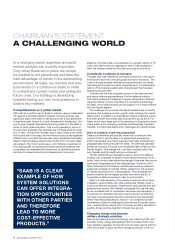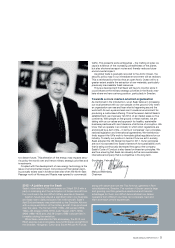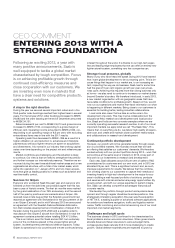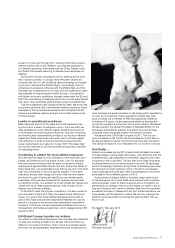Saab 2012 Annual Report Download - page 18
Download and view the complete annual report
Please find page 18 of the 2012 Saab annual report below. You can navigate through the pages in the report by either clicking on the pages listed below, or by using the keyword search tool below to find specific information within the annual report.
14 SAAB ANNUAL REPORT 2012
SAAB’S BUSINESS MODEL
OUR TECHNOLOGIES MEET
MANY DIFFERENT NEEDS
The way in which Saab addresses its cus-
tomers and markets has evolved over the
years, from close collaboration on orders of
one product by one customer to our current
broad but sharply focused range and cus-
tomers in many countries.
Close cooperation with customers and partners are crucial for
companies within the defence and security industry, and maintain-
ing cutting-edge technology requires extensive R&D (Research
& Development) efforts. Major defence orders have traditionally
included scope for some R&D nancing via government defence
appropriations, which has also generated a number of spin-off
technologies, new businesses and jobs outside the defence
industry. Over the past ten years or so, Saab has progressively
increased the share of R&D nanced internally via our earnings.
This puts pressure on industrial efciency, which is why continued
efciency efforts are one of the cornerstones of the strategy.
Enhanced service content and lifecycle
perspective extend projects
Large defence orders often include training, maintenance, support
and service and other service content, focused on functionality
and cost-effectiveness over the entire lifecycle. Functions – rather
than products and systems – are being sold to an increasing
extent, and certain functions can be outsourced; i.e., Saab can
assume responsibility for operation. One example of this is the
long-term contract Saab has with FMV: a turnkey commitment
for the SK 60 ight training system under which Saab, as main
supplier, is responsible for operation, repair and maintenance of
all SK 60 aircraft. This involves an additional business model: the
operating agreement.
Our core competence is the key to customer value
Saab is prominent in a number of key technologies, includ-
ing 4CI (Command, Control, Communication, Computers and
Intelligence), important to our reconnaissance and surveillance
systems. Several of these have broad, exible and increasing
applications in both the military and civil markets. Focusing on
this type of technology is warranted in terms of cultivating a wider
market and achieving economies of scale in production.
Saab provides our greatest customer value through its core
competence: systems integration – the ability to combine
technologies in advanced functions and more or less customise
solutions and customer applications. Some of Saab’s most suc-
cessful product concepts – including the Gripen ghter system
and our airborne surveillance systems – are complex “systems of
systems”. These hold high positions in the processing chain, while
also being cost-efcient. Read more about Gripen on pages 8-9.
Operations
Offers a product portfolio comprising the
Gripen ghter system, unmanned aerial
systems (UAS) and components for Saab’s
own aircraft and for passenger aircraft
manufactured by others. Examples of prod-
ucts: Gripen and Skeldar.
Driving factors
Growth within military aviation is driven
by nations that want new ghter aircraft
with better performance, more exibility
and better overall economic efciency.
Civilian aircraft manufacturing is driven by
growth within passenger trafc, the need
to upgrade existing eets and the need for
new aircraft. Growth within civil aviation
uctuates more with the economy than
does defence materiel.
Read more on page 46.
Operations
Offers a product portfolio with ground
combat weapons, missile systems, torpe-
does and signature management systems
for armed forces. Examples of products:
Carl-Gustaf and RBS 70 and RBS15 mis-
sile systems.
Driving factors
Complex conicts, increasingly in urban en-
vironments, require new materiel systems
and technology. Great demands are placed
on system integration, interoperability and
command and control capabilities.
Read more on page 47.
Operations
Offers a product portfolio comprising
airborne, land-based and naval systems in
radar, signals intelligence and self-protec-
tion. Examples of products: Giraffe AMB,
Erieye and Arthur.
Driving factors
Multi-national missions and new technolo-
gies drive the need for open architecture,
system integration and interoperability.
There is growing interest in long-endur-
ance solutions in which sensors and
combat management are prioritised.
Read more on page 48.
Aeronautics Dynamics Electronic Defence Systems
24% 18% 17%
of sales.
6,076 MSEK in sales 2012
of sales.
4,779 MSEK in sales 2012
of sales.
4,276 MSEK in sales 2012
























